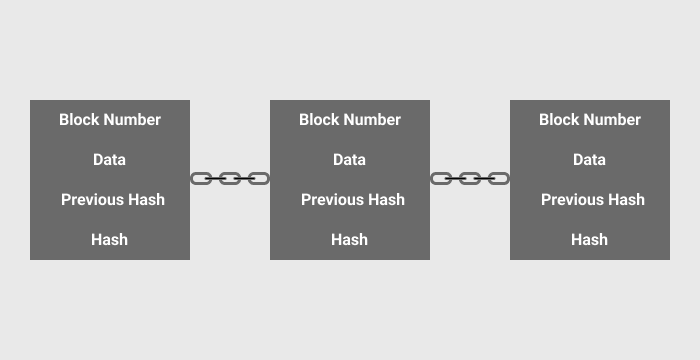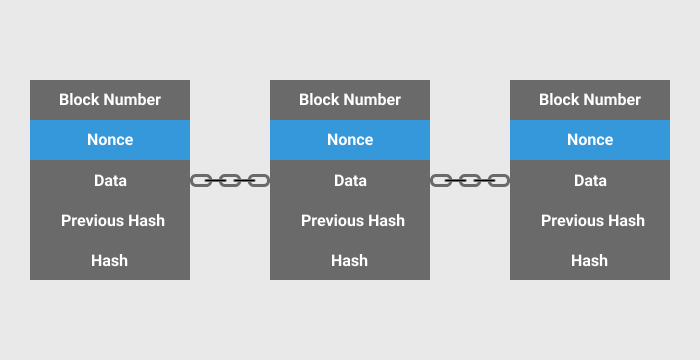Introduction
Blockchain is a fascinating subject, it has revolutionized the digital landscape, introducing unprecedented levels of security, transparency, and efficiency. So, let’s embark on this journey to understand blockchain and delve into the significance of cryptography, immutable ledgers, distributed P2P networks, mining mechanics, and consensus protocols.
What is a blockchain ?
Blockchain is an expanding series of records, known as blocks, which are securely connected using cryptographic hashes. A single block contains following fields:
- Block number: A sequential number indicating its position in the blockchain.
- Data: This can be any type of data, such as transactions, documents, etc.
- Previous hash: The cryptographic hash of the preceding block.
- Hash: The cryptographic hash of the current block.

First block in the blockchain is called the genesis block.
What is a hash ?
A hash is a value generated from input data, which can be any kind of binary data such as text, images, videos, etc., using a mathematical function called a hash function. A hash function always returns a fixed-size string of bytes, typically represented as a hexadecimal number.
5 key properties of hash function
- One-way: The original input cannot be retrieved from the hash.
- Deterministic: The same input will always produce the same hash.
- Fast computation: Hashing an input should be quick and efficient.
- Avalanche effect: A small change in the input should result in a completely different hash.
- Collision resistance: It should be difficult to find two different inputs that produce the same hash.
There are several hashing algorithms, including MD5, SHA-256, SHA-512, and SHA-3. Among these, SHA-256 is one of the most popular. Developed by the NSA, SHA-256 stands for Secure Hash Algorithm, utilizes 256 bits of memory, and is usually represented as a 64-character hexadecimal string.
Immutable ledger
Immutable ledger is a data storage system where recorded information cannot be altered or deleted. Once data is added, it is permanently stored and can only be appended with new entries, ensuring a secure, reliable, and transparent history of data. For example, when we buy a car, we register it with government authorities, and the record is added to the government’s database, which can be considered a ledger. There are many advantages to using an immutable ledger over traditional offline ledgers. In a traditional ledger, someone could remove a record by simply removing a page. In contrast, in an immutable ledger, records are stored on a blockchain. If someone tampers with a record, all subsequent records will become invalid due to a mismatch in the previous hash. However, without more advanced techniques like a distributed P2P network, tampering with the latest record is possible because there is no subsequent record to validate it.
Distributed P2P Network
It is a network architecture where each participant (node) is connected to every other node, and all nodes possess an identical copy of the blockchain. This structure significantly enhances security; if someone attempts to alter a block in a single node, the consensus mechanism will swiftly overwrite it, ensuring data integrity.
How mining works ?
Mining is akin to solving a cryptographic puzzle. The blockchain presents a mining challenge, such as setting a target to find the hash of a new block with six leading zeros. The mining node must find a hash below this target for it to be accepted into the blockchain. As previously discussed, a block contains the following fields: block number, data, previous hash, and hash.

The hash is calculated based on the block number, data, and previous hash fields. Since these three fields cannot be changed, there is another field called the nonce used for mining. The nonce is a number, usually a 32-bit unsigned integer, and it’s the only field that can be modified in the block. Miners iterate through the nonce and try to generate a hash that meets the challenge through brute force. The first miner to find the hash (also called the golden hash) is rewarded, and the hash is accepted. This entire process of finding the hash is called mining.
Consensus Protocol
A consensus protocol is a mechanism used in distributed peer-to-peer (P2P) networks to achieve agreement on a single data value among all nodes in the network. It ensures that nodes in a blockchain can agree on the same state of data, even in the presence of failures or malicious actors. Consensus protocols are essential for the correct functioning of blockchain networks.
One of the most popular consensus protocols is Proof of Work (PoW), used by cryptocurrencies like Bitcoin. PoW requires miners to solve complex mathematical problems to validate transactions and create new blocks.
For example, if two nodes mine a block at the same time, a blockchain conflict occurs. The consensus protocol resolves this conflict. Nodes will wait until a new block is mined. The blockchain with the longer chain will be considered valid, and the conflicting block will be discarded. This discarded block is called an orphaned block, and there will be no reward for it.
Conclusion
I hope this article helps you understand the fundamentals of blockchain and how its unique features contribute to its security and efficiency. As you explore further, you’ll see how this technology can revolutionize various sectors by enhancing transparency, reducing fraud, and fostering innovation.
Thanks for reading!
